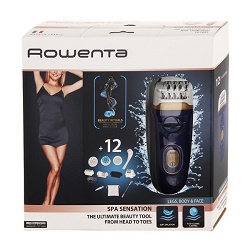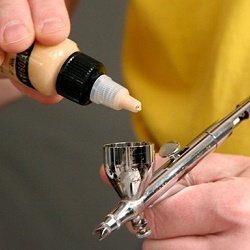The design and principle of operation of the hair dryer
This household appliance helps to dry hair for more than 75 years - the first sample of this electrical product appeared in the early 40s of the last century. Today, there is a hairdryer in almost every home, and anyone knows the rules for its use. But the internal structure of the hair dryer is familiar to only a few - we will try to fill this gap in knowledge.

Content
Structural elements and principle of operation
The design of the hair dryer does not differ in complexity: the case is made of durable plastic, inside there is a miniature fan with a powerful electric motor and heating elements made of nichrome. The principle of operation is also simple: from the back of the product, as a result of fan operation, air flow enters, which heats up to the optimum temperature, and then leaves the device through a tapering nozzle.
At the nozzle of a hair dryer for drying hair can be worn various nozzles such as a comb or a round brush for treating long hair, as is done on a product from Rowenta. Other nozzles are also used - in the form of small and large combs of different designs. A protective grid with a fine-meshed mesh is installed at the end of the device so that small objects and long hair do not fall inside.
To adjust the speed of air passage, as well as the degree of its heating, different models of hair dryer have switches mounted on the pistol grip for the convenience of users.

Standard product schemes are almost the same, with the exception of small nuances. The figure shows main parts of the hair dryer:
- fan propeller;
- electric motor;
- heating element in the form of a spiral;
- base with thermal protection;
- start button and mode switch;
- power supply cord.
As can be seen from the diagram, the hair dryer is quite simple: the main nodes are heater and fanwhich is built on the basis of a collector type of miniature electric motors for 12–18 V. A plastic propeller is rigidly mounted on its shaft, the design of which varies from one manufacturer to another.The heating element is a base made of non-combustible material, with wire threads or special spirals wound around its body. There may be several windings, which depends on the modes in which the hair dryer works, but one of them is necessarily decreasing.

Dryer heater

Blower fan
The photo shows a mini-motor and a fan, and below is a block of a heating element with two windings.

Spirals must be constantly cooled by air flow, so as not to overheat. If for some reason this does not happen, then the built-in overheat protection is immediately triggered - this is what distinguishes the most famous brands of hair dryers, for example, Phillips or Rovent.
Overheating protection system
The main purpose of the hair dryer is to dry and quickly style the hair into the hair, while the temperature of the exhaust air sometimes reaches 60 degrees. Many devices are equipped with switches that regulate the flow rate of air and its heat. To protect internal parts from high temperatures, a protection system is installed that cuts off the supply of electricity to a working product in case of emergency.
Few users know where the name of the product for hair drying came from, like a hairdryer - sometimes a dry, hot, strong and rather gusty wind comes from the mountains to the valley, which the locals gave the name foon.
In the device of any modern model there are necessarily two especially sensitive elements:
- Thermostat - a pair of closed contacts rigidly fixed on a plate of two metals with different degrees of expansion during heating. When the temperature becomes critical, the contacts open and shut off the flow of current to the engine and heating elements - the hairdryer stops working.

- Thermal fuse - This is the second line of active protection against overheating. If the first option does not work for any reason, after a few seconds the fusible element will burn out and disconnect the device from the home network. Its only drawback is that it should be changed after triggering.

Electrical circuit Fenes are not as complicated as they seem: the minimum of the main components, therefore, if you have basic knowledge of electrical engineering, you can understand it, if there is such a need. A full description is in the instruction manual for a specific product.

Typical faults
Consider the reasons for the failure of the main parts, because the failure of any of them guarantees the failure of the entire product to work, because further it will not be possible to use it without repair. Simple diagnostics can be done independently, if you know the most typical problems of these household appliances.
- Hair dryer does not turn on. It is necessary to check the serviceability of the current-carrying cord: it is possible that its frequent bends caused an internal breakage of one of the wires. If a breakdown is found, the cord must be replaced. There may be poor contact inside the product, it is necessary to check the entire electrical installation, if repair is required - contact the specialists. If the start button or switch is faulty, it should be replaced. Well, when the reason is in the electric motor - only the master can check it. Replacing or repairing the engine is impractical; it is cheaper to buy a new hair dryer.
- The product suddenly turned off - fuse blown, you need to check it and replace it. If the protection against overheating has worked, then it is necessary to wait half an hour and re-enable the product.
- No possibility to turn off the hair dryer - the start button or mode controller is faulty. Unplug the product from the outlet and call the wizard.
- The fan is not spinning: if everything is normal with the power supply, then there was a winding of the hair on the shaft, or there was a lot of foreign garbage on the blades of the impeller - clean the shaft and the blades.

- Air flow does not heat up - check the coil or thread, most likely a breakage occurred. The correct solution is to replace the helix, and not to repair it - there is no guarantee that the defect will not happen again.
- Air does not pass through the device - The air intake or installed cleaning filter is clogged. Unplug the device, disassemble and clean the grill of fluff and dust with a soft brush. If the product has a filter, unscrew the back of the case, carefully remove the filter and clean it - take great care not to damage the delicate device.

- Sometimes when the overheating protection system is triggered the smell of burning, the cause could be dust and poplar fluff, which fell on a spiral. It is necessary to clean the heating element and re-insert the product, if a similar defect again appears - contact the service center.
If your home master easily understands electrical household appliances, then you will not need the services of professional masters - all of the above failures can be eliminated by yourself.
Safe operation
In order not to visit often the service center and save time and family budget, it is necessary to strictly fulfill all requirements for operation:
- Use only standard, factory-made extension cords.
- Inspect the cord before each use of the product and do not wind it on the handle during storage.
- You can only use the attached nozzles that are included.
- Do not use the product in a room with high humidity and do not allow water to enter it.
- Install in special air intake fine mesh filter, eliminating the suction of hair inside the device.
- In the event of any malfunction - immediately disconnect the product from the mains.
- Do not pull the cord out of the socket and do not carry the device by the cord. Remember that inside its wires are not steel, but copper, which can be damaged by mechanical action.
- Do not overheat hair dryerif you need a device for long-term use - get a professional device designed for long work.
- Before placing the instrument in storage, you must give it a time to cool down for at least half an hour.
- Store the product in a dry place, the box should be locked.
With accurate performance of all recommendations, your hairdryer will work without repair, and your hairstyle will look perfect and stylish.

/rating_off.png)











